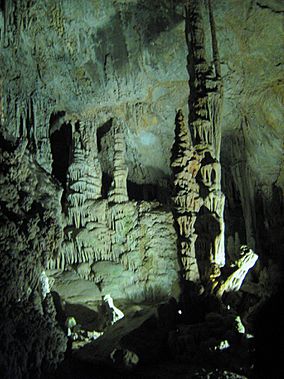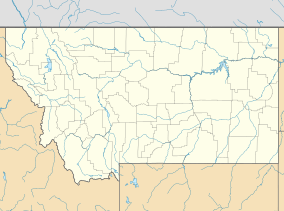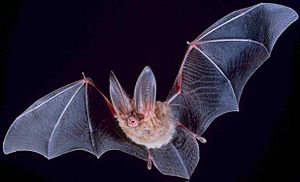Lewis and Clark Caverns facts for kids
Quick facts for kids Lewis and Clark Caverns State Park |
|
|---|---|

Illuminated interior of Lewis and Clark Caverns
|
|
| Location | Jefferson County, Montana, United States |
| Nearest town | Whitehall, Montana |
| Area | 3,015 acres (1,220 ha) |
| Elevation | 4,921 ft (1,500 m) |
| Designation | Montana state park |
| Established | 1935 |
| Administrator | Montana Fish, Wildlife & Parks |
| Website | Lewis and Clark Caverns State Park |
Lewis and Clark Caverns State Park is a huge park in Montana, covering about 3,000 acres! It's a great place for outdoor fun and protecting nature. The park is located near Whitehall, Montana. It has two visitor centers, ten miles of hiking trails, a campground, and amazing limestone caves. The Lewis and Clark Caverns area is so special that it was added to the National Register of Historic Places in 2018.
Contents
History
Discovering the Caverns
Native Americans might have known about these caverns a long time ago. However, there is no clear proof of people being inside the caves before the late 1800s. The famous Lewis and Clark Expedition camped near the caverns on July 31, 1805. They were along Antelope Creek, but they never actually saw the caves.
In 1892, local ranchers Tom Williams and Bert Pannel were hunting when they saw steam coming from the caverns. This led to their discovery. Later, two people from Whitehall, Charles Brooke and Mexican John, claimed they found the cavern in 1882. But there is no real evidence to support their story. In 1898, Tom Williams finally explored the caverns with some friends.
From National Monument to State Park
Around 1900, a man named Dan A. Morrison started giving tours of the cave. He called it Limespur Cave. In 1905, he tried to claim the land, but a railroad company disagreed. The railroad won in court and gave the land to the United States government.
The site officially became "Lewis and Clark Cavern National Monument" on May 11, 1908. It was fully surveyed and declared by President William Howard Taft on May 16, 1911. The monument was about 160 acres. The cave is named after explorers Meriwether Lewis and William Clark. This is because the cavern overlooks more than 50 miles of their expedition trail along the Jefferson River. Even though the explorers never saw the cave, they did pass through parts of what is now the park.
The caverns are also special because much of the work to make them safe for visitors was done by the Civilian Conservation Corps (CCC). This was a group of young men who worked on public projects during the 1930s.
In 1937, the caverns were no longer a national monument. The National Park Service decided they were not important enough to be a national site. So, the land was given to the state of Montana. On April 22, 1938, Morrison Cave became Montana's first state park. The park was officially opened in May 1941. In 2018, the park was listed on the National Register of Historic Places.
Geology
How the Caverns Formed
Lewis and Clark Caverns were created by slightly acidic groundwater. This water slowly dissolved layers of limestone rock. This limestone formed from tiny sea creatures that died in an ancient sea. This happened between 325 and 365 million years ago!
Later, around 70 million years ago, a reddish sandstone layer was pushed up. This event, called the Laramide Orogeny, created cracks in the limestone. These cracks were the beginning of the caves. Most of the cave system was probably carved out during the ice ages. At that time, there was much more water flowing through the ground than there is today.
Townsend's Big-Eared Bats
The caverns are home to western big-eared bats. There used to be hundreds of them, but now there are about 50 to 150 female bats that use the caverns each year. They come here to have their babies, called pups. The male bats are thought to live in other nearby caves.
These bats are very helpful because they eat thousands of insects every day! Bats are amazing creatures. They have thumbs that can grab things, and they are the only mammals that can truly fly. In 2012, the caverns celebrated the "Year of the Bat." Now, "Bat Week" happens every August at the park, with special programs about bats. During World War II, the Civilian Conservation Corps collected bat droppings, called guano, from the caves. This guano was used to make important materials. You can also find tiny creatures called springtails living in the caves.
Activities
Lewis and Clark Caverns State Park is open every day of the year, except for Thanksgiving, Christmas, and New Year's Day. However, the caverns themselves are only open for guided tours from May 1 to September 30. They also offer special holiday tours in December.
What to Do at the Park
There are many fun things to do at the park, including:
- Bicycling
- Bird watching
- Camping
- Fishing
- Hiking
- Mountain biking
- Picnicking
- Photography
- Visiting the playground
Cave Tours
Guided tours of the caverns are available from May 1 to September 30. There are three different tour options:
- Classic Cave Tours: These tours are about 2 miles long and last two hours.
- Paradise Tours: These are shorter, about one mile long, and last about an hour.
- Wild Cave Tours: These tours are offered on Sundays and Tuesdays from mid-June to mid-August. They are three hours long and involve a lot of crawling, so they are quite challenging!



